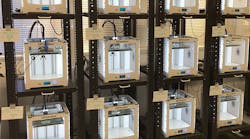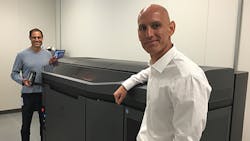John Dulchinos and the rest of his team at Jabil Circuit received their new Multi Jet Fusion 3-D printer from HP back in June and, for months, they have fiddled with the technology. Process development. Characterization capabilities. Figuring out the limits of what, exactly, is possible, when you print as quick as 340 million voxels per second.
The catch, of course, was that as an HP foundational partner, Jabil received the pre-production printer — perfect for tinkering, not so much for actual commerce.
“From a legal standpoint, we couldn’t technically make real parts on the pre-production unit,” said Dulchinos, VP of global automation and 3-D printing. “They wouldn’t stand behind the printer’s delivering at a level that would be considered parts that we could conduct commerce with.”
Now, though, after more than five months, Dulchinos and Jabil are ready to shift into a higher gear — and actual production — thanks to a pair of Jet Fusion 3D 4200 Printer production units. As outlined in an IndustryWeek magazine story earlier this year, the new units can print about 10 times faster than any other 3-D printer currently available, potentially producing stronger parts, shortening cycles, even overhauling supply chains.
“These are the first printers that HP has delivered that can be used to produce real production-grade parts,” Dulchinos said. “They have the capability to produce parts that have a level of mechanical integrity, a level of finish and quality and speed that allows us to start to find use cases that move into thousands of units break-even points, and even tens of thousands of units break-even points.”
Dulchinos talked with IW about the buzz of finally receiving the printers and how Jabil plans to incorporate them in the months and years ahead.
Jabil Circuit
Jabil Circuit COO Bill Muir, right, and John Dulchinos, VP, Global Automation and 3-D Printing, show off the first installation of the HP Jet Fusion Printer, which 3-D prints 10 times faster than any other current machines.
IW: What does this do for you, for your customers, and for the industry that wasn’t previously possible?
JD: At the highest level, the real value proposition of 3-D printing has always been to produce parts — in this case, we’re focusing on plastics, not metals — without having to produce custom fixtures and jigs or molds. If you look at a traditional manufacturing process for a plastic part, it’s mold-driven. That mold can be a temporary mold, made out of lower-cost materials like aluminum, or it can be a mold that’s made out of higher-cost materials like stainless steel. You invest in a mold that costs tens of thousands of dollars, if not hundreds of thousands of dollars, depending on its complexity, so if you want to make a part, you have to buy a very expensive, part-specific mold before you make your first part. By default, if the mold costs $20,000, it costs you $20,000 just to make the first part.
The injection molding industry has been built around being optimally costed for hundreds of thousands or millions of units, but when you get down to hundreds or thousands of units, it’s not super cost-efficient. So what 3-D printing enables is the ability to produce a part from a digital file without having to make a mold. The cost of part 1 is the same cost as part 1,000 is the same cost as part 10,000. When you think about applications where the volumes are low, … 3-D printing starts to become a viable alternative.
IW: Couple that low volume ability with increased production speed, and you have a favorable solution.
JD: Where it really excels in value is when you start to think about the ability to create more customized and personalized products. Today, because of just the inherent cost to make, … 3-D printing allows you to open up your thinking and say, instead of making 10,000 of the same thing, you can make 10 different versions and more accurately target a market solution. In the extreme case, if you want to make personalized products, like footwear, 3-D printing makes it such that if you’re making 1,000 different variants instead of one, the costs are essentially the same.
Cutting Across All Industries
IW: What else has you excited?
JD: There’s a saying in 3-D printing about getting complexity for free. What that means, essentially, is that regardless of how complex the geometry is, the costs don’t fundamentally change for a part — from a simple part to a complex part — whereas in traditional manufacturing, it could double or triple the price of the part. … Those are the general values of 3-D printing. The challenge to date has been that 3-D printers haven’t had the ability to take those cool value statements and deliver a part that has real mechanical integrity, and a level of finish worthy of creating real parts. That’s where HP’s comes in.
We’ve engaged with a number of customers over the last five months, and in the last two or three months, we’ve been in a state where we could really start engaging. We’ve got conversations going on, projects we’re defining. It’ll be a little while before we can get that to market and be able to talk about it. With most of these applications, you have to be able to walk before you run. … What they’re really excited about is, yes, the compression of the NPI process, a much-reduced time to market, and the ability to produce at a lower volume level all the way down to customized without absorbing costs. And it cuts across different industries.
IW: The 3-D printing conversation always seems to gravitate more toward the consumer. Can this focus it a little more on industry, on manufacturing?
JD: The sexy stuff centers around consumer things. That’s just where everything seems to gravitate. … Invisalign has proved that with customized braces, and that’s kind of the high-profile, glitzy aspect of 3-D printing. But really, to me, there is a just a tremendous amount of low-volume stuff made that uses plastic parts across every industry segment. We have that here at Jabil: 80% of the plastic parts we source have volumes below 20,000 units per year. There’s so much stuff today made out plastic that isn’t very high-volume and is produced very inefficiently. I think there are some real, clear use cases, and some compelling transition points to move 3-D printing into kind of mainstream applications, relatively quickly.
I think customization is cool, and we certainly have engagements there, but that has a longer gestation period, just because of the importance of it. What I get excited about is, 3-D printing has these tremendous scenarios around customization and personalization, but there’s this whole kind of traditional manufacturing — kind of in the bowels of manufacturing, the fixtures and tooling — to now these lower-volume, higher-mix products that aren’t efficiently covered well. That opens the door to companies starting to think about the opportunity not to have to live with 10,000 units that are exactly the same.
IW: If we look ahead three months, six months, maybe nine months, how do you see this affecting what you do?
JD: If we decide to make a plastic part somewhere, there has to be a mold associated with it. If we want to make it in two locations, there have to be two molds. If we want to make it in three locations, there have to be three molds. As we start to roll out these printers into a wide set of plants and locations, every plant now has the capacity to make parts. I can much more, now, seamlessly rebalance my supply chain by saying, “Gee, rather than concentrating it all in China, let’s put 30% this week in China, 30% in Mexico, and 40% in the U.S.” As demands change, we can seamlessly move it, because all we’re doing is moving a digital file. We don’t have to replicate fixtures and molds in different locations. It can open the door to distributed manufacturing.
What’s noteworthy is that HP has brought to market one of a very small set of technologies that can produce parts at quality, at scale, at a level of mechanical integrity and cost, that can allow these applications to open up today. That’s what’s noteworthy about this. Anybody can talk about these use cases, but until you have a tool that can deliver the level of functionality needed, they’re all just academic ideas that can’t really get executed. We can start to implement these ideas now.





